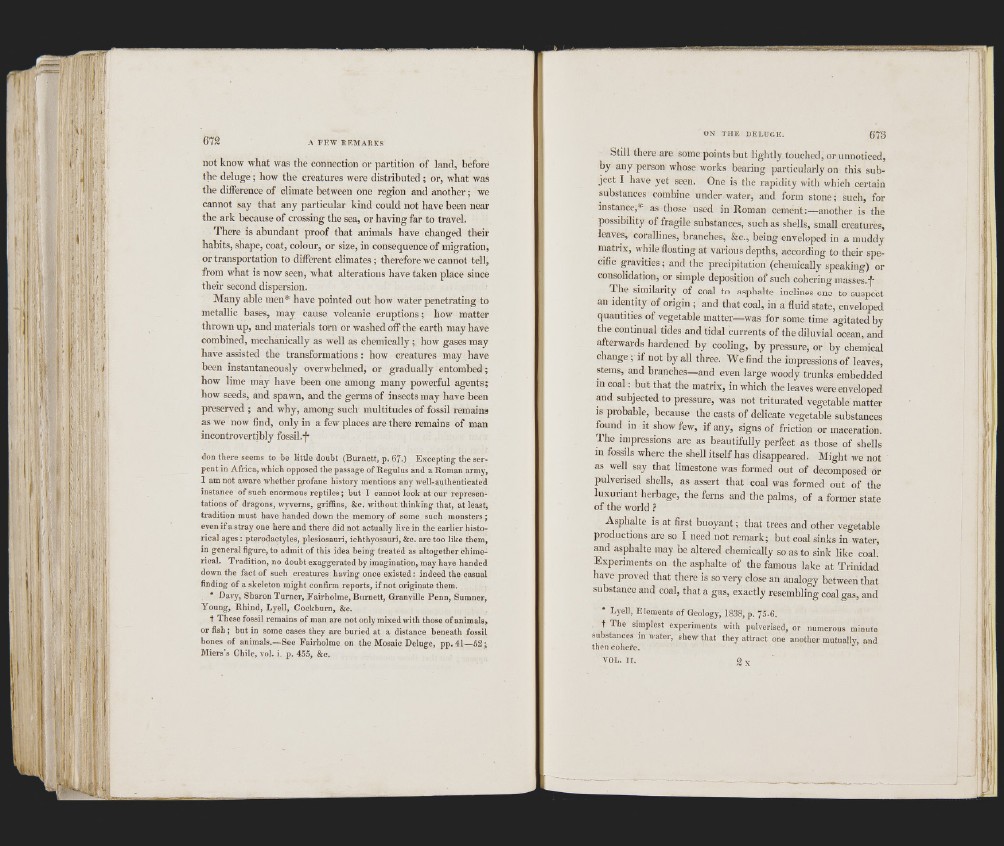
''1 1
i l I
M '
n
7 ‘
I l . la
not know what was the connection or partition of land, before
the deluge; how the creatures were distributed ; or, what was
the difference of climate between one region and another ; we
cannot say that any particular kind could not have been near
the ark because of crossing the sea, or having far to travel.
There is abundant proof that animals have changed their
habits, shape, coat, colour, or size, in consequence of migration,
or transportation to different climates ; therefore we cannot tell,
from what is now seen, what alterations have taken place since
their second dispersion.
Many able men* have pointed out how water penetrating to
metallic bases, may cause volcanic eruptions; how matter
thrown up, and materials torn or washed off the earth may have
combined, mechanically as well as chemically ; how gases may
have assisted the transformations : how creatures may have
been instantaneously overwhelmed, or gradually entombed ;
how lime may have been one among many powerful agents;
how seeds, and spawn, and the germs of insects may have been
preserved ; and why, among such multitudes of fossil remains
as we now find, only in a few places are there remains of man
incontrovertibly fossil.#
don there seems to be little doubt (Burnett, p. 67.) Excepting the serpent
in Africa, which opposed the passage of Regulus and a Roman army,
1 am not aware whether profane history mentions any well-authenticated
instance of such enormous reptiles ; but I cannot look at our representations
of dragons, wyverns, griffins, &c. without thinking that, at least,
tradition must have handed down the memory of some such monsters ;
even if astray one here and there did not actually live in the earlier historical
ages : ptérodactyles, plesiosauri, ichthyosauri, &e. are too like them,
in general figure, to admit of this idea heing treated as altogether chimerical.
Tradition, no doubt exaggerated by imagination, may have handed
down the fact of such creatures having once existed ; indeed the casual
finding of a skeleton might confirm reports, if not originate them.
* Davy, Sharon Turner, Fairholme, Burnett, Granville Penn, Sumner,
Young, Rhind, Lyell, Cockburn, &c.
t These fossil remains of man are not only mixed with those of animals,
or fish ; but in some cases they are buried at a distance beneath fossil
bones of animals.—See Fairholme on the Mosaic Deluge, pp. 41—52;
Miers's Chile, vol. i, p. 455, &c.
Still there are some points hut lightly touched, or unnoticed,
hy any person whose works bearing particularly on this subject
I have yet seen. One is the rapidity with which certain
substances combine underwater, and form stone; such, for
instance,’- as those used in Roman cement:—another is the
possibility of fragile substances, such as shells, small creatures,
leaves, corallines, branches, &c., being enveloped in a muddy
matrix, while floating at various depths, according to their specific
gravities ; and the precipitation (chemically speaking) or
consolidation, or simple deposition of such cohering masses.#
The similarity of coal to asphalte inclines one to suspect
an identity of origin ; and that coal, in a fluid state, enveloped
quantities of vegetable matter—was for some time agitated by
the continual tides and tidal currents of the diluvial ocean, and
afterwards hardened by cooling, hy pressure, or by chemical
change ; if not by all three. We find the impressions of leaves,
stems, and branches—and even large woody trunks embedded
in coal : but that the matrix, in which the leaves were enveloped
and subjected to pressure, was not triturated vegetable matter
IS probable, hecause the casts of delicate vegetable substances
found in it show few, if any, signs of friction or maceration.
The impressions are as beautifully perfect as those of shells
in fossils where the shell itself has disappeared. Might we not
as well say that limestone was formed out of decomposed or
pulverised shells, as assert that coal was formed out of the
luxuriant herbage, the ferns and the palms, of a former state
of the world ?
Asphalte is at first buoyant; that trees and other vegetable
productions are so I need not remark; but coal sinks in water,
and asphalte may be altered chemically so as to sink like coal.
Experiments on the asphalte of the famous lake at Trinidad
have proved that there is so very close an analogy between that
substance and coal, that a gas, exactly resembling coal gas, and
Lyell, Elements of Geology, 1838, p. 75-6.
t The simplest experiments with pulverised, or numerous minute
substances in water, shew that they attract one another mutually, and
then cohei'e.
VOL. II. 2 X